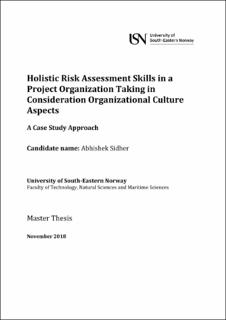| dc.description.abstract | Risk management is one of the critical elements for a successful project. In the present industrial scenario risk management model developments have been more rapid and advanced in the recent past 10-15 years. This is mainly due to changing market structure in terms of competition and the stakeholders demand for efficiency and client demands.
In general, the approach towards risk management across industry especially shipbuilding and offshore oil & gas industry is broadly qualitative in nature.
In offshore industry the application of risk management models can be considered as structured and tends to cover the value chain across the organization and uniform in their implementation as well. All other sectors involving heavy investments and complicated processes too have their own risk management models for handling the risk elements faced by them. This is again driven by the nature of business and the type of competition prevalent.
In practice, risk management is a multi-faceted function-oriented activity in an organization. For example, Risk management requires inputs by all members of a project organization. This ranges from risk identification to risk monitoring. One of the challenges in risk assessment is that personnel like a designer in the office or a supervisor at the yard may only assess risks for their functional targets. As a result, risk registers in Engineering Procurement Installation Commissioning (EPIC) projects report risks which are more execution based but don’t register risks having impact on the overall project interests. This leads to unforeseen risks at times when it was already identified but the risk was never registered appropriately to catch the client’s attention.
Organizational culture on the other hand is a critical element too which tends to affect the overall organization’s day to day working as well its approach towards project execution. An organizational culture which tends to lean towards an environment with prime focus on market and business opportunities may tend to be aggressive in its intent for customer satisfaction and organization’s overall growth through commercial success. While an organization with an inclination towards characteristics such as adhocracy may tend to be more encouraging towards innovative ideas and vision development-based success path.
The purpose of this study is to verify the holistic alignment of risk assessment by the project members across an organization within a standardized risk management system where assessment and measurement process may be influenced by organizational culture.
The study focuses to establish this possibility through a project case study in an organization. The chosen project is in a mature phase of its completion and chosen for the same purpose due to the possibility of getting more reflective answers from the personnel. The current areas of risk management and organizational culture are deep subjects in their individual ways and this makes it harder to clearly establish a hard link but it does point the possibility that a possible influence exists. The results from the study were confirmed based on the statistical analysis to be genuine but some of the support theories like possibility of holistic alignment wasn’t clearly established. | en_US |
